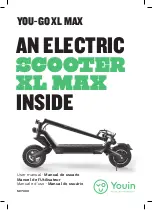
www.jawamoped.com
3. RIDING INSTRUCTIONS
A. Check before a ride:
1 the fuel in the tank.(To remove the filler cap
rotate it anticlockwise.) Mix oil with fuel
according to the Lubrication Chart. To fill the tank
use a funnel with strainer.
2. the brakes, lights and buzzer
3 the tyre pressure - front - 1,5 atm.g. (21p.s.i.)
- rear - 1,9 atm.g. (27 p. s. i.)
4. whether the gear change pedal is in its neutral
position
B. Starting the engine.
1. Open the fuel tank tap through the opening in
the rear cowl R. H. side (Fig. 9).
2. Flood the carburettor by pressing the tickler
pin through the opening in the R. H. side of the
front cowl (Fig. 21).
3. Switch the switch box lever in the headlamp
nacelle to the central position (Fig. 8).
4. Kick the starter pedal down (in the direction of
travel) to start the engine.
C. Riding
Starting from standstill:
To engage bottom gear
depress the clutch lever. With the tip of your left
foot push lightly the gear change pedal right, up,
moving the machine slightly at the same time, until
bottom gear is engaged(fig. 6). Opening the
throttle release the clutch lever slowly and
gradually (especially in the second half of its travel
when the machine starts moving off) to start off
smoothly. Having reached the speed of 9-12 m.p.h.
(15-21 km.p.h.) depress the clutch lever while
closing the throttle. With the tip of your left foot
depress fully the gear change pedal and release it.
Second gear is thus engaged. Release quickly the
clutch lever and open the throttle.
Having reached the speed of 17-25 m.p.h. (2840
km.p.h.) engage top gear in a similar way.
Do not use force when operating the gear change
pedal, as you might damage the gear change
mechanism and bend the gear change lever.
Permissible speeds in individual gears;
Bottom gear 0 to 13 m.p.h. (0 to 20 km.p.h.)
Second gear 9 to 25 m.p.h. (15 to 40 km.p.h.)
Top gear up from 17.mp.h. (33 km.p.h.)
Most economical and suitable speeds in individual
gears:
Bottom gear 6 to 12 m.p.h. (10-20 km.p.h.)
Second gear 12 to 21 m.p.h. (18-34 km.p.h.)
Top pear 10 to 31 m.p.h. (30-50 km.p.h.)
Riding up hill.
As soon as the engine revolutions
begin to drop when riding uphill change to lower
gear. To change from top to second gear change
lever up. Changing down has to be done more
quickly than changing up, the climbing machine
would otherwise lose speed while the clutch is
depressed.
Engage bottom gear in the same way.
Braking:
When riding downhill or stopping
(slowing down) use the brakes. Closing the
throttle
depress first the rear wheel brake lever
and only
then use the front wheel hand brake.
If possible,
use the brakes with caution and
gradually, sudden
braking makes the wheels skid.
Special care is
recommended when braking
on slippery ground
and when coming from a hard
surface to a dusty
road.
Stopping:
When stopping close the throttle,
depress the clutch lever, brake and shift into
neutral between the bottom and second gear.
This
is done by pressing (pushing) the gear
change
lever down (up) half the way necessary
to engage
a gear. To stop the engine, turn the
switch box
lever to the left (Fig. 8). Do not
forget to turn off
the fuel tap (Fig 9). Having
finished riding for the
day let the engine run
at low revolutions with the
fuel tap closed till
all the fuel in the carburettor is
consumed. With
the engine at a standstill, the oil
in the mixture in the carburettor might choke the
jet.
Night riding:
When riding during the night
(or in
fog) switch on the headlamp and tail light
by
turning the switch box lever to the right
(Fig 8).
Main and dipped beam is controlled
by the dip
switch on the L.H. handlebar.
4 of 18
JAWA 50 type 20, 21, 23, 23A Owners Handbook page 13 to 16
jkw
If the clutch lever of the JAWA 50 scooter
is depressed before starting, the clutch will
slip. Therefore, do not de-clutch when
starting the engine. If the clutch lever has
been depressed by accident, push-start the
machine.
Important: when a higher gear is engaged,
the engine operates in lower revolutions
than before. Do not try to prevent this by
depressing the clutch lever and letting the
clutch slip. When the clutch is slipping the
excessive friction overheats the clutch
plates and the plates may burn.




































